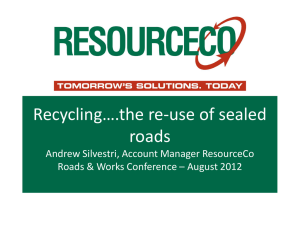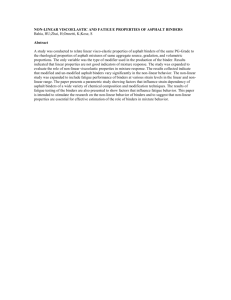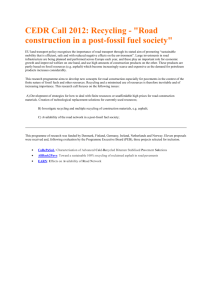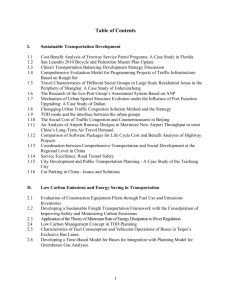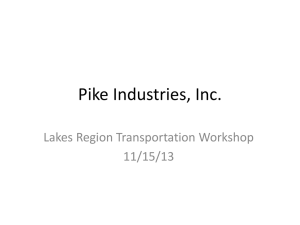AAPA_Study_Tour_2011..
advertisement
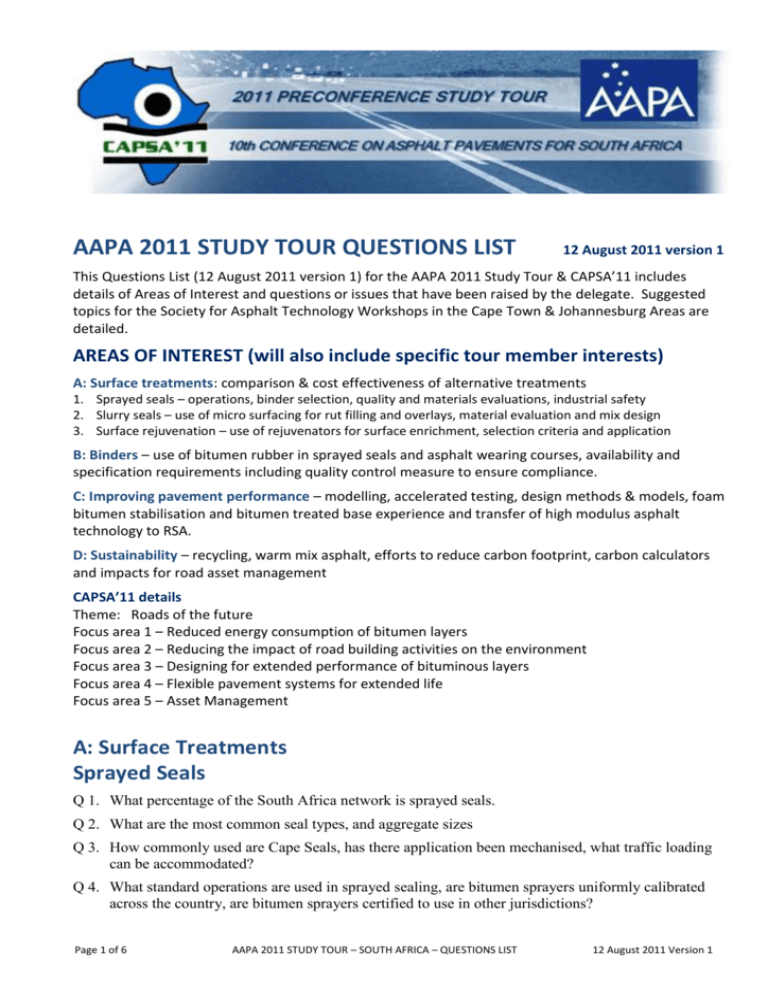
AAPA 2011 STUDY TOUR QUESTIONS LIST 12 August 2011 version 1 This Questions List (12 August 2011 version 1) for the AAPA 2011 Study Tour & CAPSA’11 includes details of Areas of Interest and questions or issues that have been raised by the delegate. Suggested topics for the Society for Asphalt Technology Workshops in the Cape Town & Johannesburg Areas are detailed. AREAS OF INTEREST (will also include specific tour member interests) A: Surface treatments: comparison & cost effectiveness of alternative treatments 1. Sprayed seals – operations, binder selection, quality and materials evaluations, industrial safety 2. Slurry seals – use of micro surfacing for rut filling and overlays, material evaluation and mix design 3. Surface rejuvenation – use of rejuvenators for surface enrichment, selection criteria and application B: Binders – use of bitumen rubber in sprayed seals and asphalt wearing courses, availability and specification requirements including quality control measure to ensure compliance. C: Improving pavement performance – modelling, accelerated testing, design methods & models, foam bitumen stabilisation and bitumen treated base experience and transfer of high modulus asphalt technology to RSA. D: Sustainability – recycling, warm mix asphalt, efforts to reduce carbon footprint, carbon calculators and impacts for road asset management CAPSA’11 details Theme: Roads of the future Focus area 1 – Reduced energy consumption of bitumen layers Focus area 2 – Reducing the impact of road building activities on the environment Focus area 3 – Designing for extended performance of bituminous layers Focus area 4 – Flexible pavement systems for extended life Focus area 5 – Asset Management A: Surface Treatments Sprayed Seals Q 1. What percentage of the South Africa network is sprayed seals. Q 2. What are the most common seal types, and aggregate sizes Q 3. How commonly used are Cape Seals, has there application been mechanised, what traffic loading can be accommodated? Q 4. What standard operations are used in sprayed sealing, are bitumen sprayers uniformly calibrated across the country, are bitumen sprayers certified to use in other jurisdictions? Page 1 of 6 AAPA 2011 STUDY TOUR – SOUTH AFRICA – QUESTIONS LIST 12 August 2011 Version 1 Q 5. Are bitumen rubber & polymer modified binder sprayers different to normal bitumen sprayers – are they calibrated & certified differently? Q 6. How are road surface types selected, is there a local or national norm, what factors are considered when selecting the given surface? Are there particular treatments used for particular reasons? Q 7. Is the type of binder to be used included in the selection process or is that determined by the seal design process? Q 8. What range of road grade and modified binders are used in sprayed sealing and what volumes or percentages are sprayed annually? Q 9. Are polymer modified emulsions used in sprayed sealing? If yes what are the key motivators and what are the operational and cost implications? Q 10. Does the public sector participate in sprayed sealing (percentage private to public)? Q 11. Are binders bought in bulk by the client? If yes how is binder allocated to contracts? Q 12. Are newer sprayers with different international technologies being used? Q 13. Has the comparative performance of the various polymer modified binders and rubber bitumen used in seals been reviewed? Q 14. Are performance or functional specifications used in the purchase of surface seals? Q 15. Are there best practice procedures for: a. surface pre-treatments including rut filling, b. surface rejuvenation and crack sealing; c. cutting back of binders, d. the use of bitumen emulsions; e. use of self propelled chip spreaders versus spreader boxes, f. calibration of sprayers, g. on site blending of bitumen rubber, h. pre-coating of aggregates, and i. priming of base courses. Q 16. Are performance or functional specifications used in the purchase of surface seals? Q 17. What allowances are made in the variations of material qualities to achieve optimal use of scarce natural aggregates? Is this included integrated into the seal design and the performance evaluation? Q 18. What impacts have industrial occupational health and safety requirements had on sprayed sealing operations and materials selection? Slurry Seals Q 1. What is the primary use of slurry seals? Urban networks? Rural network? Q 2. Are slurry / micro-surfacings used as rut filling and overlays? What life expectancy is achieved? What mix design methods are used? Any lessons learnt or best practice guides? Are there performance records? Q 3. Is the equipment used of a similar type / standardised? Q 4. Are slurry / micro-surfacings sold under brand names? Are they included in a HAPAS type certification process? Surface Rejuvenation Q 1. Is surface enrichment a common practice? Q 2. What is the primary motivation for using surface rejuvenation? Page 2 of 6 AAPA 2011 STUDY TOUR – SOUTH AFRICA – QUESTIONS LIST 12 August 2011 Version 1 Q 3. Is it included in seal design and application? Q 4. What selection / performance criteria are used in choosing a surface enrichment product? Q 5. What application rates are used? What are the costs / area of the products used? Q 6. What binder types are used for surface enrichment? Q 7. Are special commercial products / petroleum product formulations used for rejuvenation? B: Binders Q 1. Does South Africa import bitumen yet? If not, why not? Q 2. Are penetration or viscosity graded binders used? Q 3. Are there different specifications for asphalt and sprayed sealing grades of road grade and modified binders? Q 4. Is any attempt made to compare to international grades of binders (Superpave Performance Grading)? Q 5. What tests are used to evaluate the binder properties over the operational temperature spectrum? Q 6. Are cut-back binders used, if yes what percentage of the overall binder usage? Are there best performance guides for blending cutback in the field? Q 7. What elastomeric and plastomeric modifiers are available? Does the specification identify them by type? What relative percentages of the modifiers are used? Q 8. Is crumb rubber (bitumen rubber) commonly used? In sprayed sealing? In asphalt? What percentage in each application? Q 9. How is crumb rubber included in sprayed sealing? Direct mixing in bitumen sprayers? Terminal blending and long distance hauling? Field blending at point of application? Q 10. Does environmental benefit or sustainability enter into consideration in the selection of binders? Q 11. What efforts are being made to use alternatives to crude oil sourced bituminous binders? Are their binders commercially available? Q 12. What modified binders are commonly used in asphalt manufacture? Is the selection based on performance? Have long term performance trials been undertaken to assess the advantages? Q 13. Has accelerated pavement testing (HVS) been used to assess the performance improvements for modified and bitumen rubber for seal and asphalt? If yes, have the results been included in design guides? Q 14. Do specifications, test procedures and best practice guides exist for crumb rubber binders (bitumen rubber)? Q 15. What attempts have been made to improve the plastomeric properties of crumb rubber binders? Q 16. Are high modulus asphalt technologies available? What lessons have been learnt in the acquisition of the necessary materials and skills to deliver the asphalt? Will the material be subjected to APT and is it likely to be included in the SA Pavement Design Method? C: Improving Pavement Performance Q 1. What is Godzilla and is it likely to spread into other countries? Feedback on this clearly a big and ambitious project and its links to performance records, wider range of engineering and reference testing and use in full pavement & surfacing performance would be valuable! Q 2. Is the Fatigue Endurance Limit concept to be included in South African pavement design? Page 3 of 6 AAPA 2011 STUDY TOUR – SOUTH AFRICA – QUESTIONS LIST 12 August 2011 Version 1 Q 3. Is the “perpetual pavement concept” of value and is the international efforts on this likely to impact on pavement thickness design? Q 4. What accelerated pavement testing is being undertaken? How is it input into current design models? Are there links to international APT facilities? Are there links to the NCAT test track? Q 5. Has the investment in APT improved the performance of the South African roads network? Explain if yes. Q 6. What key pavement evaluation tests for network level evaluation? Is Ground Penetrating Radar being used? Are standard network level tests undertaken across the South African network or are the results assessed differently in each of the Provinces? Q 7. Is pavement maintenance funded nationally? And if so, what basis is used nor allocation of pavement repair funding in non-national jurisdictions? Does this have an impact on the overall level of service of the roads? Q 8. Does the economic development value of road infrastructure enter into the provision of roads and the pavement types / structures selected? Q 9. What relative amounts of foam and emulsion stabilised base courses are used? Are there performance & design models available? What development work is being undertaken? Are there clearly different applications for emulsion vs foam stabilastion? Q 10. What new concepts and pavement performance options are under research? Q 11. What sustainability and CO2 reduction drivers exist in the roads sector and how are they being evaluated and addressed against pavement performance? Are trade-offs permitted for reduced performance but improved sustainability? (use of lower standard materials, recycled waste materials etc) Q 12. D: Sustainability Q 1. What percentages of recycled asphalt is used in South Africa? Estimated tonnage? Does it vary by urban / regional and by Province. Q 2. What percentages of RAP are allowed in wearing course, binder course, base course? Q 3. Are their restrictions on the use of modified binders in RAP? Are their restrictions on the use of RAP in modified binder mixes? Q 4. What sustainability and CO2 reduction drivers exist in the roads sector? Q 5. Are recycled waste materials (glass, concrete, brick, sulphur etc ) permitted for use in asphalt? If yes, what proportions? Q 6. Are carbon foot print and CO2equi calculators being used? If yes, which ones? Q 7. Are there C02equi reduction initiatives in the purchase of bituminous surfacings or asphalt pavements? Q 8. Do road asset management policies include carbon reduction? What initiatives are in place to reduce any impact? Q 9. Is warm mix asphalt and low energy asphalt being routinely used? What implementation strategy was used to introduce and evaluate the WMA performance? Q 10. What warm mix asphalt technologies are in regular use? Q 11. General Questions Page 4 of 6 AAPA 2011 STUDY TOUR – SOUTH AFRICA – QUESTIONS LIST 12 August 2011 Version 1 From Derek Millar – QTMR 1. 2. 3. 4. 5. 6. 7. (Question for Louw) recall back in my SANRAL days that the texture depths for SMA surfacings typically dropped significantly after year 5 (SANRAL use to measure annually / bi-annually their network texture depths etc). I would be interested to ascertain if the texture depths had got any worse or if loss of texture tapered off. Usually we would expect 1.2 - 1.5 mm texture depth at construction which was much better than 0.7 for the DG mixes so perhaps not an issues when starting off much higher? Also, on my last project it was more cost effective to use a 20mm UTFC layer on a 35mm DG14 type mix than a 50mm SMA. So it made sense to use this approach rather than the SMA. I would like to know if SANRAL is still using SMA or has it's use dropped off since the introduction of UTFC type surfacings? I still like the idea of a composite asphalt layer and believe that like the French we should be using a UTFC surfacing seal that is replaced every 6-8 years on our higher level roads here in QLD. On rural roads we should use double seals. (Question for Dennis Rossman) I understand that SANRAL are looking at G1 bases with 1% emulsion. I have wondered for a long time whether there is any benefit in this and proposed it years ago. Has SANRAL started any trials with this and if so what are the results like thus far? (Question for Low) Because SANRAL have such a good network measurement system in place they also put allot of emphasis in asset preservation projects (these normally get first priority when allocating their annual budget with capex expenditure secondary ) it would be interesting to see the volumes of surfacing undertaken i.e. seals (type - single. double, rubber bitumen), asphalt surfacings (UTFC, SMA, DG) and concrete? Between 2000 and 2007 when I left, SANRAL applied allot of double seals (strictly 1.5 seals) over their rural and sometimes urban freeways; how have these fared now that they have had 5 years and more traffic? I think the design life was 6-8 years. They were mostly modified seals some where bitumen rubber. (Question for Dennis Rossman) As far as I am aware SANRAL have only used foam bitumen bases on low risk roads (i.e R22 - be interesting to know how the R22 has performed?); has the use of foam bitumen bases increased or is the G1 base still the preferred base option? This would also apply for subbase layers where SANRAL in the past mostly use lime, slag or cement stabilised subbases? (Question for Dennis Rossman)There were a few SANRAL projects that used a concrete inlay with an asphalt surfacing in truck lanes (N2 just south of Durban), how have these performed to date and is it an option that SANRAL will continue to use? Page 5 of 6 AAPA 2011 STUDY TOUR – SOUTH AFRICA – QUESTIONS LIST 12 August 2011 Version 1 Workshop Topics Suggested by Hosts in South Africa (some still awaited) 1. Presentation by Trevor Distin and Rob Vos on the switch to imported bitumen in Australia – the reasons, the good the bad & the future 2. Presentation on Australian Sprayed seal practice – extreme seal design (John Esnouf) leading to the proposed Southern Hemisphere Sprayed Seal Alliance (Kym Neaylon). 3. Open – as required (Potential high strength lime stabilization of very poor clay soils – Peter Evans) 4. Open – as required etc etc etc. Australian’s would like to hear about: (these could be different in the Cape & Gauteng) 1. Bitumen rubber in seal and asphalt – what works well and what to learn from 2. Use of HAPAS style purchasing for thin high asphalt surfaces – including details of your 15mm micro surfacing 3. Use of polymer modified emulsions is seals – reasons and learnings 4. Developing stronger pavements – HiMA – the journey and the status 5. Surface seals practical use in very high demand situations 6. Details of implementation of Warm Mix Asphalt and the green / sustainable advantages with RAP 7. Training initiatives and formal recognition of qualification in the road pavements & surfacing industry 8. Threats and perceived threats to the roads sector in Africa Page 6 of 6 AAPA 2011 STUDY TOUR – SOUTH AFRICA – QUESTIONS LIST 12 August 2011 Version 1


